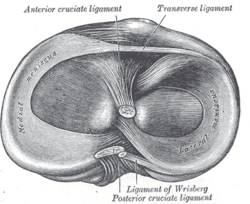
Back Kraakbeenskyf Afrikaans هلالة (تشريح) Arabic Меніск (анатомія) Byelorussian Менискус Bulgarian Menisc (anatomia) Catalan Meniskus (anatomie) Czech Мениск (анатоми) CV Meniskus (Anatomie) German Μηνίσκος Greek Menisco (anatomía) Spanish
| Meniscus | |
|---|---|
 Head of right tibia seen from above, showing menisci and attachments of ligaments | |
 Left knee-joint from behind, showing interior ligaments | |
| Details | |
| Identifiers | |
| Latin | meniscus |
| Greek | μηνίσκος ("meniskos") |
| MeSH | D000072600 |
| TA98 | A03.0.00.033 |
| TA2 | 1544 |
| Anatomical terminology | |
A meniscus (pl.: menisci or meniscuses) is a crescent-shaped fibrocartilaginous anatomical structure that, in contrast to an articular disc, only partly divides a joint cavity.[1] In humans, they are present in the knee, wrist, acromioclavicular, sternoclavicular, and temporomandibular joints;[2] in other animals they may be present in other joints.
Generally, the term "meniscus" is used to refer to the cartilage of the knee, either to the lateral or medial meniscus. Both are cartilaginous tissues that provide structural integrity to the knee when it undergoes tension and torsion. The menisci are also known as "semi-lunar" cartilages, referring to their half-moon, crescent shape.
The term "meniscus" is from the Ancient Greek word μηνίσκος (meniskos), meaning "crescent".[3]